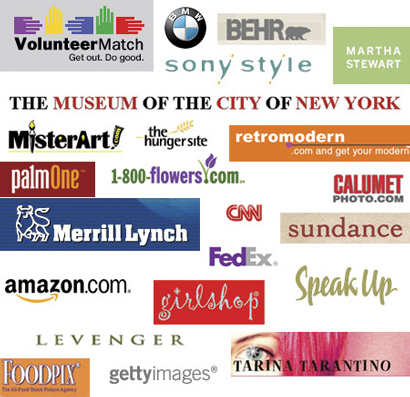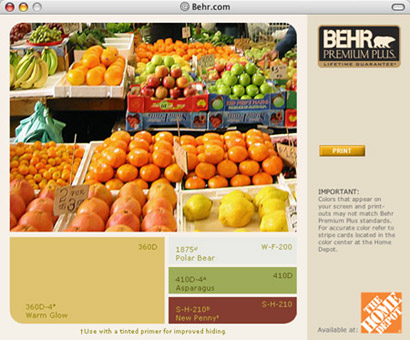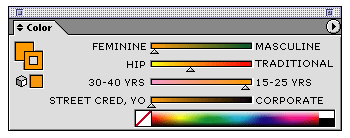So you find yourself sitting in the middle of a room with lots of ideas, samples, color chips and scraps from cool magazines trying to figure out what color should go on the wall, the trim, the shelving unit… should you go with contrasting colors or a simple tone on tone? Would your significant other forgive you if you went for the eye-prickling orange hue? With a burgundy trim? Would it be safer (alias “boring”) to go with beach sand tones… Would your kids dig it?
The same can be said of when after many hours/days/weeks you are at the point in which you like your design and it’s time to choose your color palette. Where to start? Corporate colors. Yuck. Mood setters… hmmm… I don’t know. What about a trendy combo? I mean, some of the colors we have to work with are quite something:

You look out the window and get some ideas from mother nature, orange and green, white and blue, lavender and plum with a hint of off-white? What makes a given color work with another? And what makes a color combination successful? Because Martha Stewart would use it one of her collections?
Behr understands how hard a decision this can be, and how daunting for the inexperienced or overwhelmed. They offer a series of tools to help you out:
a. Inspiration: articles and images help you create practical, artistic, emotional, fashionable and/or historical choices.

b. Explore Color: It helps and guides you by having you choose one color and giving you options to combine with (neutral, contrasting, calming, etc.), you can go back and modify your colors, and even place them in a room to get an idea of what it will look like in your home.

Pantone� provides us with the Pantone COLORTEAMSM which can help us with some recommendations, seasonal direction, color meanings (by culture and country), but you need to contact them by phone or email. This is great, but different from what Behr has to offer, which is giving us a tool to spark our imagination, and help us get to the vision that you can see but can’t grasp just yet.
As a designer it is important to know and understand color, to know how to work with it, and yet we usually complain about the corporate colors we have to deal with in many of our projects. Why do you think this is?
If we are the best people to decide which colors best communicate and represent our client’s needs, which color combinations carry our message to the right consumers in the best possible way, why are we (many a time) bitching about our own doing?







Both Behr tools are actually pretty damn cool. (Hello 70s color palette!). While I like to think (and say) that color comes magically to me in my dreams and through pure intangible inspiration it is totally informed by all the things that are portrayed in these two Behr tools. In fact, I see myself going there for those times when I am not "inspired" and will be happy to accept that I got the color combination off some public-targeted tool for people who should be on Trading Spaces.
I think a cool tool for designers would be some sort of application that initially gave you a palette of 2-3-4 colors and then — being the picky asses we tend to be — we could tweak some of the values and that would in response alter the other colors to match the hues, saturations, etc… actually, what would be like totally cool is if it had values for things like Feminine vs Masculine or Hip vs Traditional, and you could slide the value between them to get a color palette. I would then bitch about how lazy designers are who use the Colorthron 2000� to select their colors. But it would be kind of a cool thingie.
In the meantime common sense will have to do I guess.
On May.04.2004 at 05:31 PM